Soybean Response to Planting Rates and Row Spacings in North Dakota (A1961, June 2020)
North Dakota State University has a long tradition of recommending the establishment of a soybean population of 150,000 plants per acre across row spacings. This recommendation continues to exist across the state to optimize soybean seed yield (Kandel and Endres, 2019).
NDSU has conducted numerous field trials, including Schmitz et al., 2020, during recent years to examine the impact of planting rates and row spacings on soybean production. With the large amount of data available from across the state, the opportunity existed to re-evaluate the current recommendation and provide a more precise soybean planting rate and row spacing recommendations.
This publication summarizes the evaluation of data generated by NDSU soybean field trials conducted during 2008 through 2019 in North Dakota that included planting rates and row spacing.
Data Compilation and Analysis
Table 1 provides general information on the 37 NDSU soybean trials that provided the data used in this publication. A total of 390 data points (observations) comprise the database.
| Table 1. NDSU soybean planting rate and row spacing trials, 2008-2019. | |||||
| Number | Sites | Year | Planting rates: pure live seed/acre (x1000) | Row spacings: inches | Trial mean: bu/acre |
| 1 | Carrington | 2008 | 150, 200 | 14, 28 | 40.3 |
| 2 | 2008 | 150, 200 | 14, 28 | 47.1 | |
| 3 | 2009 | 150, 200 | 14, 28 | 53.6 | |
| 4 | 2010 | 150, 200 | 14, 28 | 70.3 | |
| 5 | 2011 | 150, 200 | 14, 28 | 55.9 | |
| 6 | Prosper | 2009 | 150, 200 | 14, 28 | 53.8 |
| 7 | 2010 | 150, 200 | 14, 28 | 49.2 | |
| 8 | 2018 | 80, 100, 120, 140, 160, 180, 200, 220 | 12, 24 | 44.7 | |
| 9 | Fargo | 2011 | 150, 200 | 14, 28 | 48.5 |
| 10 | 2011 | 150, 200 | 14, 28 | 55.3 | |
| 11 | 2017 | 80, 100, 120, 140, 160, 180, 200 | 12, 24 | 39.2 | |
| 12 | 2017 | 80, 100, 120, 140, 160, 180, 200, 220 | 12, 24 | 40.3 | |
| 13 | 2017 | 80, 100, 120, 140, 160, 180, 200, 220 | 12, 24 | 42.3 | |
| 14 | 2018 | 80, 100, 120, 140, 160, 180, 200 | 12, 24 | 37.8 | |
| 15 | 2018 | 80, 100, 120, 140, 160, 180, 200 | 12, 24 | 38.8 | |
| 16 | 2018 | 80, 100, 120, 140, 160, 180, 200, 220 | 12, 24 | 40.9 | |
| 17 | 2018 | 80, 100, 120, 140, 160, 180, 200, 220 | 12, 24 | 41.5 | |
| 18 | 2019 | 165, 185 | 12, 24 | 49.6 | |
| 19 | 2019 | 165, 185 | 12, 24 | 57.2 | |
| 20 | 2019 | 165, 185 | 12, 24 | 44.6 | |
| 21 | 2019 | 165, 185 | 12, 24 | 53.6 | |
| 22 | Minot | 2013 | 100, 150, 200 | 7, 21, 30 | 54.1 |
| 23 | 2016 | 75, 100, 125, 150 | 10, 20 | 39.7 | |
| 24 | Garrison | 2016 | 75, 100, 125, 150 | 7, 14, 21 | 23.8 |
| 25 | Rugby | 2016 | 75, 100, 125, 150 | 7, 14, 21 | 40.2 |
| 26 | Williston | 2016 | 90, 120, 150, 180 | 7.5, 15, 22.5, 30 | 18.7 |
| 27 | 2017 | 90, 120, 150, 180 | 7.5, 15, 22.5, 30 | 24.3 | |
| 28 | 2018 | 90, 120, 150, 180 | 7.5, 15, 22.5, 30 | 15.0 | |
| 29 | Ransom Co. | 2017 | 80, 100, 120, 140, 160, 180, 200, 220 | 12, 24 | 56.2 |
| 30 | Sargent Co. | 2017 | 80, 100, 120, 140, 160, 180, 200, 220 | 12, 24 | 49.0 |
| 31 | 2018 | 80, 100, 120, 140, 160, 180, 200, 220 | 12, 24 | 60.4 | |
| 32 | Steele Co. | 2017 | 80, 100, 120, 140, 160, 180, 200, 220 | 12, 24 | 53.2 |
| 33 | 2018 | 80, 100, 120, 140, 160, 180, 200, 220 | 12, 24 | 39.7 | |
| 34 | Hettinger | 2018 | 80, 100, 120, 140, 160, 180 | 7, 30 | 37.3 |
| 35 | 2019 | 80, 100, 120, 140, 160, 180 | 7, 30 | 43.0 | |
| 36 | Casselton | 2019 | 80, 100, 120, 140, 160, 180, 200, 220 | 12, 24 | 60.0 |
| 37 | 2019 | 60, 80, 100, 120, 140, 160, 180 | 12, 30 | 45.2 | |
Each data point is the treatment average of the trial, with three to four replications contributing to the treatment average. Western sites include trials from Garrison, Hettinger, Minot, Rugby and Williston, and the remaining trial sites are designated as eastern.
Seed yield was normalized for each trial by comparing the treatment average to the overall trial mean. The treatment average within each individual trial was divided by the trial mean and multiplied by 100 to get the relative yield in percent (the trial mean was set at 100%).
With all yield data on the same scale (relative percent), data were evaluated across trials. In each figure, the dots represent the averaged relative yield for each factor evaluated. For example, each dot in Figure 1 represents the average of all observations in all trials as indicated in Table 1 for the planting rate indicated.
Figure 1. Soybean relative seed yield with planting rates averaged across row spacings, North Dakota, 2008-2019.
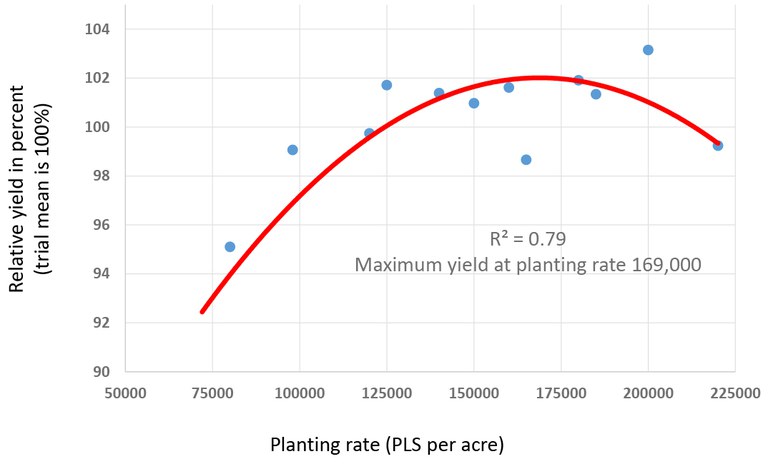
Excel was used to sort, review and analyze yield data among individual factors (planting rates and row spacing), factor interaction and geographic regions (eastern and western). Figures were prepared that include polynomial (poly.) or linear regression trendlines and R-squared values associated with these trendlines. Based on these equations, the planting rate with the highest yield was calculated and is provided in the figures.
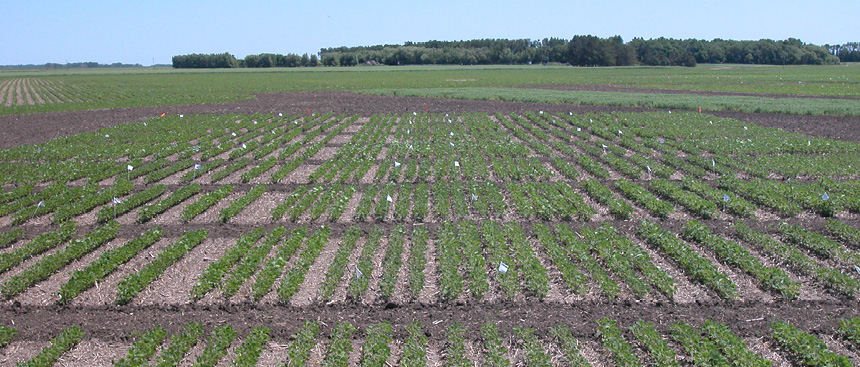
Results and Discussion
Planting Rates
The relative soybean seed yield among planting rates, ranging from 80,000 to 220,000 pure live seeds (PLS) per acre, averaged across row spacings and all North Dakota site-years, is shown in Figure 1. Planting rates of 125,000 to 200,000 PLS per acre generally provided above-average yield, with 169,000 PLS per acre producing optimum agronomic yield.
Figure 2 shows relative soybean seed yield among planting rates, ranging from 80,000 to 220,000 PLS per acre, averaged across row spacings and eastern North Dakota site-years (28 trials). Planting rates of 135,000 to 200,000 PLS per acre generally provided above-average yield, with 180,000 PLS per acre producing optimum agronomic yield.
Figure 2. Soybean relative seed yield with planting rates averaged across row spacings, eastern North Dakota, 2008-2019.
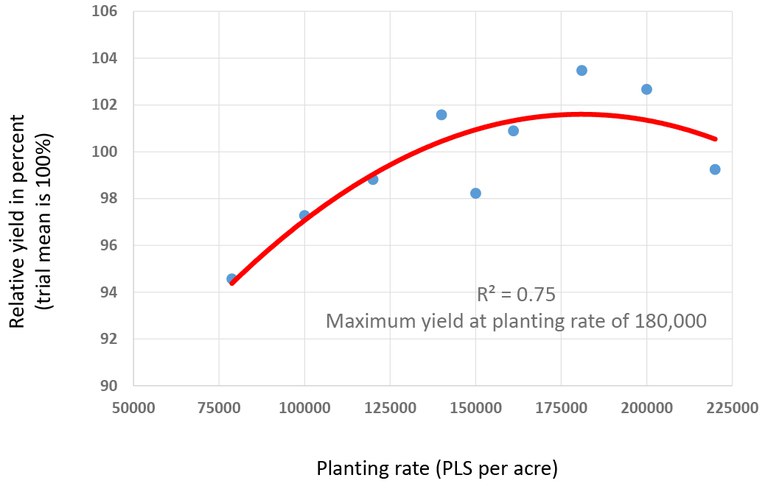
Figure 3 displays the early season (several weeks after plant emergence) plant population (y-axis) resulting from planting rates (x-axis) averaged across the soybean trials from eastern North Dakota. The average early season plant population of all North Dakota trials was 138,000 and was 92% of planting rates of 150,000 PLS per acre. Therefore, 8% of the PLS did not develop into viable plants.
Figure 3. Soybean planting rates and established stand, eastern North Dakota, 2008-2019.
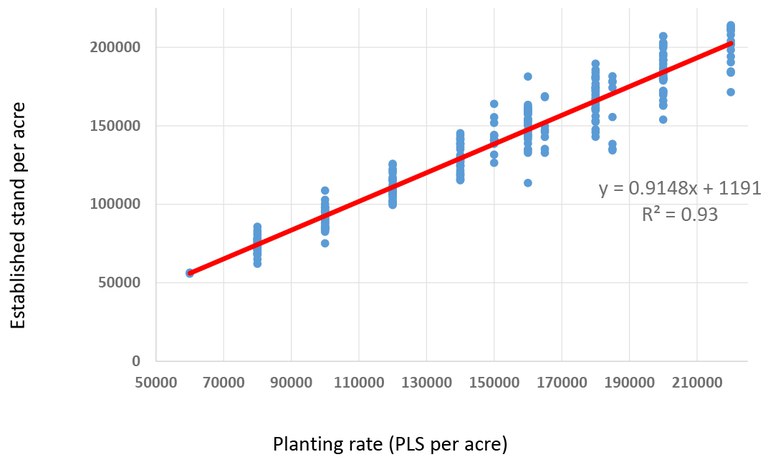
The number of plants established for evaluated planting rates in this study varied for each trial environment based on factors including seed quality, planter setting, planting conditions, soil moisture and rainfall after planting. Analysis of western trials did not include plant population because the majority of trials did not include this data.
Recommendations for the optimum agronomic planting rate in this publication are based on live seeds planted and not on established plants per acre. If planting in conditions where greater seed mortality is expected, adjust the planting rate up accordingly. If the plant establishment rate can be improved effectively, the amount of PLS needed for optimal plant stands can be reduced.
The relative soybean seed yield among planting rates, ranging from 80,000 to 180,000 PLS per acre, averaged across row spacings and western North Dakota site-years (nine trials) is shown in Figure 4. Planting rates equal or greater than 120,000 to 160,000 PLS per acre provided above-average yield, with 141,000 PLS per acre producing optimum agronomic yield.
Figure 4. Soybean relative seed yield with planting rates averaged across row spacings, western North Dakota, 2013-2019.
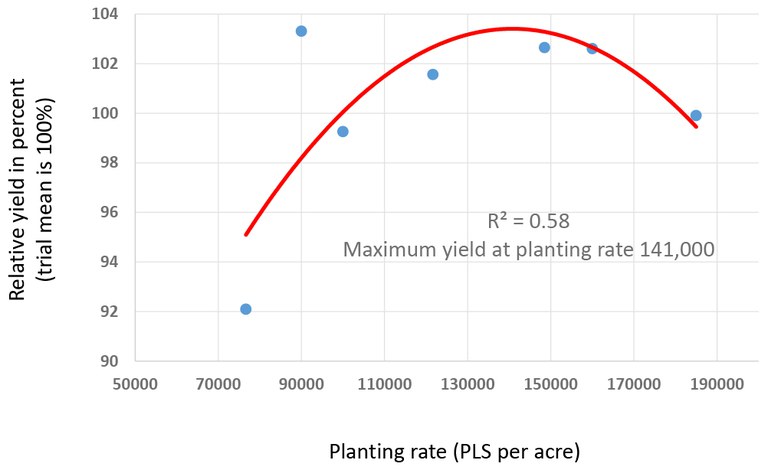
Row Spacings
The relative soybean seed yield among row spacings ranging from 7 to 30 inches and averaged across planting rates and all North Dakota site-years is shown in Figure 5. Based on the regression equation, the relative yield increases by 0.5% for each inch the spacing is narrower than 30 inches. Narrow rows (less than 15 inches) provided above-average yield. Seven-inch rows yielded the greatest at about 106% of the relative trial yields based on the regression equation.
Figure 5. Soybean relative seed yield with row spacings averaged across planting rates, North Dakota, 2008-2019.
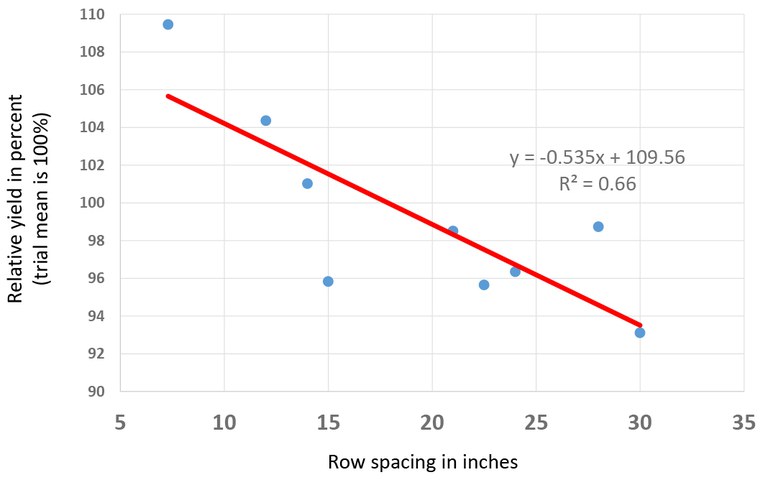
Planting Rates and Row Spacings
Figure 6 shows the relative soybean seed yield between narrow (12 to 14 inches) and wide (24 to 30 inches) row spacings among planting rates 60,000 to 220,000 PLS per acre, averaged across eastern North Dakota site-years. Narrow rows had greater yield among all planting rates, compared with wide rows.
Figure 6. Soybean relative seed yield with row spacings and planting rates, eastern North Dakota, 2008-2019.
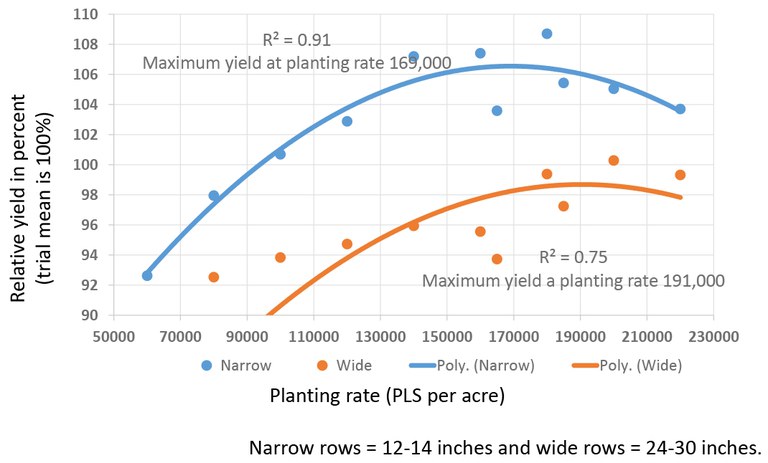
Yield response to planting rates generally was similar between narrow and wide rows. Optimum yield with narrow and wide rows was obtained with planting rates of 169,000 and 191,000 PLS per acre, respectively.
The relative soybean seed yield among narrow (7 to 10 inches), intermediate (14 to 22.5 inches) and wide (30 inches) row spacings among planting rates, ranging from 75,000 to 180,000 PLS per acre, averaged across western North Dakota site-years is indicated in Figure 7. Narrow rows had greater yield among all planting rates, compared with wider rows, and yield was optimized with narrow rows at 152,000 PLS per acre.
Narrow row yield was greater than trial averages at all planting rates, while yield with intermediate and wide rows generally were less than trial averages. Trendline variability was likely due to the limited western database.
The data presented describe the results in terms of the agronomic optimum planting rate. Of more importance to farmers is the economic optimum planting rate, which gives the highest economic return from the seed planted.
Generally, the economic optimum planting rate is lower than the agronomic optimum rate. Using the optimum planting rates documented in this publication as a starting point, farmers and crop advisers can adjust the numbers based on soybean seed costs and projected market prices to fit their needs.
Figure 7. Soybean relative seed yield with row spacings and planting rates, western North Dakota, 2013-2019.
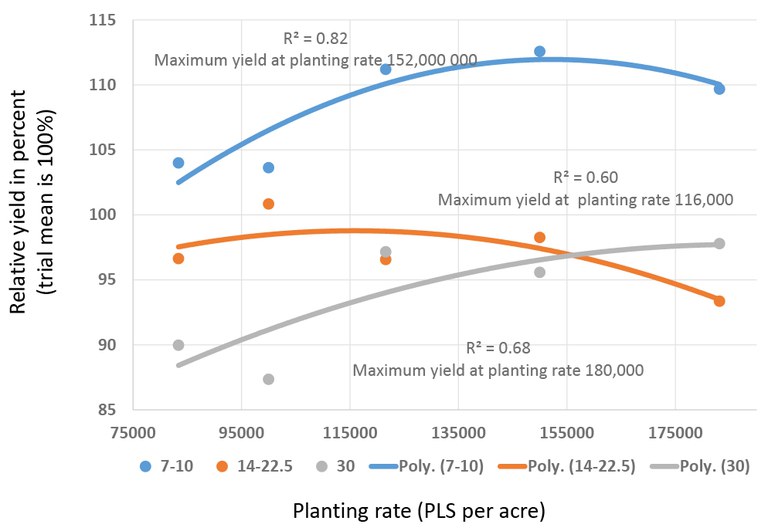
Summary
- Across North Dakota and row spacings, the planting rate of about 170,00 PLS per acre optimized soybean seed yield, while optimum yield occurred with 180,000 and about 140,000 PLS per acre in eastern and western North Dakota, respectively.
- In eastern trials, 8% of planted PLS per acre did not develop into viable soybean plants. Assuming 8% of PLS does not result in established plants across North Dakota, and using 170,000 PLS per acre, about 155,000 plants per acre would be expected to maximize yield.
- Across North Dakota or by regions, narrow rows (less than 15 inches) consistently provided greatest soybean yield.
- In eastern North Dakota, the combination of narrow rows (12 to 14 inches) and planting rates of about 170,000 PLS per acre provided optimum yield. If planting in wide rows (24 to 30 inches), planting rates to reach the optimum yield were about 190,000 PLS per acre.
- In western North Dakota, the combination of narrow rows (7 to 10 inches) and planting rates of about 150,000 PLS per acre provided optimum yield.
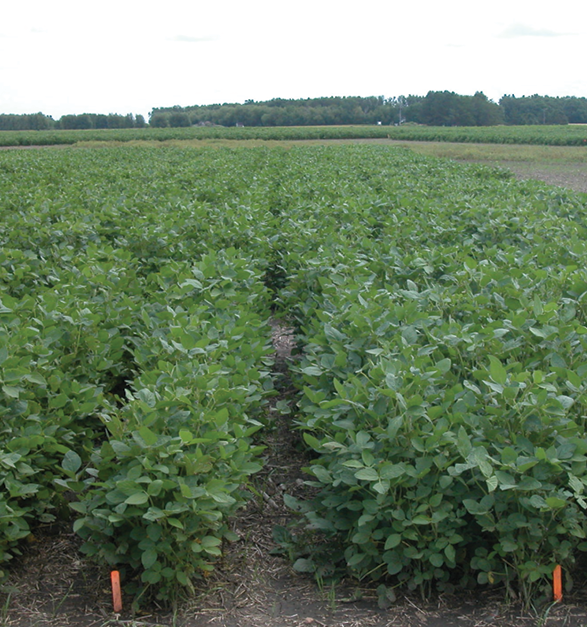
References
Kandel, H.J. and G.J. Endres. Soybean production field guide for North Dakota. NDSU Extension publication A1172. Revised April 2019.
Schmitz, P.K., J.D. Stanley and H.J. Kandel. 2020. Row spacing and seeding rate effect on soybean seed yield in North Dakota. Crop, Forage and Turfgrass Management. https://doi.org/10.1002/cft2.20010


The North Dakota Agricultural Experiment Station and North Dakota Soybean Council supported the research used in this publication.

